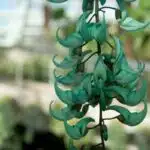Have you ever seen a Purple Passion Vine and been intrigued by its beauty? As a botanist and gardener, I have had an affinity for these extraordinary plants since my childhood. So it’s no surprise that when I started working in this profession, the Purple Passion Vine was one of the first plants I learned to grow and care for.
In this article, I will share with you everything you need to know about growing and caring for your very own Purple Passion Vines. From planting tips to watering advice, you will learn exactly how to make sure your Purple Passion Vines thrive in any environment. You’ll also get all the necessary information on how to spot signs of disease or pests so that you can keep your plants healthy and vibrant year-round.
Whether you’re a novice gardener or an experienced professional, this article will provide all the essential knowledge you need to make sure your Purple Passion Vines are happy and flourishing! So let’s get started – read on to learn more about how to successfully grow and care for these stunning plants!
Choosing A Location For Purple Passion Vine
Choosing a location for purple passion vine is like finding the perfect spot for a painting – it needs to be just right. As a botanist and gardener, I recommend picking somewhere that gets full sun with some afternoon shade in hot climates. Be sure to check the hardiness zone of your area before planting so you don’t put it in an environment too cold or hot; purple passion vine will grow best in USDA zones 9-11.
When deciding where to place your vine, make sure you have enough space for it to reach its full potential. Purple passion vines can grow up to 15 feet or more and spread out 10-15 feet wide, so you’ll want plenty of room for them to climb on structures or trellises. It’s also important to find an area that won’t be disturbed by things such as foot traffic or lawn mowers, as this can damage its roots and stems.
If you don’t have any structures like arbors or trellises nearby, then consider using stakes, wire mesh, garden twine, etc., to provide support for the vine as it grows. Once you’ve found the perfect location with plenty of sunlight and room for growth, you’re ready to move onto soil requirements for purple passion vine.
Soil Requirements For Purple Passion Vine
The second step in growing and caring for purple passion vine is understanding its soil requirements. As a specialist in botany and gardening, I can tell you that this plant prefers well-draining, moist soil. It should be slightly acidic to neutral, with a pH range of 6.0 to 7.5. Add organic matter like compost or manure to the soil to improve drainage and fertility as needed.
In addition, ensure your soil has adequate nutrients for the plant’s growth. Mulch around the base of the vine to help retain moisture in the soil and reduce weeds. You’ll want to fertilize regularly during the growing season with a balanced fertilizer or compost tea for optimal results.
Finally, remember that purple passion vine requires consistent moisture throughout its growing season. Make sure you water it deeply every week during this time so that it can grow strong and healthy roots. This will provide an ideal environment for it to thrive and flourish!
Sunlight Requirements For Purple Passion Vine
The sun is an essential component for the growth of any plant, and the Purple Passion Vine is no exception. This gorgeous climber needs plenty of sunlight to thrive and develop its fragrant blooms. As a Specialist in botany and gardening, I’m here to discuss the light requirements for cultivating this wonderful plant.
Let’s begin by alluding to the fact that although direct sunlight is ideal, the Purple Passion Vine can still survive in partial shade. It’s important to note that while the plant may grow in such conditions, it won’t reach its full potential. Hence, if you want your vine to truly blossom, then you must ensure that it receives at least six hours of direct sunlight on a daily basis. This amount of light will help promote flowering as well as strengthen its structure by promoting robust stem growth with increasing foliage density.
Furthermore, these vibrant climbers need good air circulation around their leaves so they don’t become susceptible to fungal diseases in hot and humid climates. To achieve this, you must prune them regularly while also positioning them near open windows or balconies where there’s sufficient airflow throughout the day. Doing so will not only give your plant more exposure to light but also help improve its overall health and vigor.
So if you’re looking to liven up your garden with some deep purple hues this season, I’d recommend growing a Purple Passion Vine! With just enough sunlight and proper care, this stunning climber will bring beauty and color into your outdoor space while adding a touch of elegance too!
Water Requirements For Purple Passion Vine
Unlike many other plants, the Purple Passion Vine is not too picky when it comes to sunlight. It prefers full sun and partial shade, but will tolerate complete shade. When grown in full sun, however, its foliage tends to be greener and more vibrant.
When it comes to water requirements for the Purple Passion Vine, they are quite simple – it needs an adequate amount of water both in the ground and on the foliage. The soil should remain moist at all times, but not overly wet or soggy. In addition, it’s important to mist the foliage regularly to keep its leaves looking healthy and vibrant.
In order to ensure optimal growth for your Purple Passion Vine, it’s important to fertilize regularly with a balanced fertilizer that contains nitrogen, phosphorus, and potassium. It’s best to fertilize during springtime when new growth is beginning and again in mid-summer when the plant is actively growing. TIP: Just remember to follow label directions carefully – over-fertilizing can damage your purple passion vine!
Fertilizer Requirements For Purple Passion Vine
Much like a painter carefully selecting the right colors to bring a masterpiece to life, so too must gardeners carefully select the right fertilizer to help cultivate their desired results. Fertilizing purple passion vine is an integral part of its growth and care. It’s an art that requires finesse and expertise, and when done correctly, can produce a vibrant display of beauty in any garden.
To make sure your purple passion vine flourishes, here are three key things you should consider:
- Selecting the Right Fertilizer: When picking out a fertilizer for your purple passion vine, opt for one that has a balanced ratio of nitrogen, phosphorus, and potassium.
- Frequency of Feeding: To ensure optimal health for your plant you should fertilize it every 10 days during the growing season.
- Amount to Use: When feeding your purple passion vine use 1/2 teaspoon of fertilizer per gallon of water.
Fertilizing is an essential part of caring for a purple passion vine as it ensures proper nutrition and growth. With the right amount of feedings at regular intervals, you’ll have beautiful blooms all year round! Now that we’ve covered fertilization requirements let’s delve into how to properly prune this stunning plant.
Pruning Purple Passion Vine
Pruning purple passion vine is like pruning a bonsai tree: with careful trimming and precise shaping, you can create an elegant masterpiece. In botany and gardening, pruning is essential for maintaining a healthy and attractive purple passion vine. It’s important to understand the basics of how and when to prune this unique flowering plant.
The best time to prune your purple passion vine is in the late winter or early spring before new growth begins. Start by removing any dead or broken vines, as well as any diseased or overly vigorous stems. Also cut back any branches that are growing beyond their desired shape, such as those that are drooping too low or extending too far outward. Aim for evenly spaced branches that form an aesthetically pleasing silhouette.
When you’re done cutting back your vines, it’s important to give them a bit of extra TLC. Pruning improperly can cause more harm than good, so be sure not to remove more than one-quarter of the total foliage at once. Applying some compost or fertilizer after pruning helps support healthy new growth and encourages fuller blooms in the summer months.
By following these guidelines for pruning your purple passion vine, you’ll be rewarded with an attractive specimen that looks great year-round and will keep your garden looking its best!
Propagating Purple Passion Vine
Propagating purple passion vine is a simple process that can be done in the home garden. To propagate, begin by taking cutting from healthy, mature vines and trimming the stems to about 4-6 inches in length. Make sure there are at least two nodes on each stem and dip them in a rooting hormone before planting them into well-draining soil or potting mix. Once planted, keep the cuttings consistently moist and provide bright, indirect sunlight for best results.
It’s important to note that cuttings should not be taken until the plant is established as it can weaken its health. When propagating purple passion vine this way, it may take several weeks for the cutting to begin producing new growth. Patience is key! If you’re looking for quicker results, consider propagating through air layering instead.
Not only will air layering produce a new plant much faster than traditional propagation methods, but it’s also incredibly easy to do! All you need to do is choose a healthy stem with at least two nodes and wrap sphagnum moss around the stem before covering it with plastic wrap or aluminum foil. Then wait for roots to emerge before snipping off the newly rooted cutting and placing it in a pot of soil or potting mix. With proper care, your new purple passion vine will soon be thriving!
Controlling Pests And Diseases On Purple Passion Vine
An interesting statistic to note about purple passion vine is that it can grow up to 30 feet in length. Controlling pests and diseases on purple passion vine is an important part of its care. Here are 4 points to consider when maintaining this plant:
Monitor your vines regularly for signs of pests or disease. This includes looking out for discolored leaves, damaged stems, and other irregularities.
Be sure to water your plants properly, as improper watering can lead to issues like mildew or fungus growth.
If you see signs of pest infestations, try removing the affected parts of the plant with a pair of scissors or pruning shears. This will help reduce the spread of the problem.
Provide good air circulation by keeping plants away from walls and other objects that may block airflow around them.
When dealing with pests and diseases on purple passion vine, it’s important to take preventive measures such as proper pest monitoring, proper watering, and providing good air circulation around the plants. Additionally, if any infestations do occur, then removing affected parts of the plant immediately can help stop further spread of the problem and promote healthy growth for your vines in the future. With these tips in mind, you’ll be able to ensure that your purple passion vine stays healthy and thriving all year round! Now let’s look at how we should be caring for our purple passion vines during wintertime.
Winter Care For Purple Passion Vine
Ah, winter. When the frosty air begins to bite and the ground is covered in white, purple passion vine owners know that it’s time for special care to ensure a healthy plant come spring. While other plants may be able to withstand cold temperatures, purple passion vines require some specific TLC during the winter months. Here are just a few of the steps gardeners must take:
Protecting from Frost: As temperatures drop below 32°F (0°C), frost can cause serious damage to purple passion vines. To protect them from frost, cover them with burlap or another type of fabric and make sure they’re well-insulated.
Pruning: Pruning is an essential part of maintaining a healthy purple passion vine. Prune back dead growth and reduce overall height by cutting off any long stems that may be susceptible to freeze damage or wind damage.
Mulching: For extra protection against extreme cold, add mulch around the base of the plant. This will help keep soil temperatures more consistent and provide insulation against harsh weather conditions.
As botanists, we understand how difficult it can be to maintain a healthy green oasis during these colder months – which is why we recommend taking extra precautions when caring for your purple passion vine in wintertime! With proper care and attention, you can rest assured that your plant will thrive come springtime!
Harvesting And Using The Fruits Of Purple Passion Vine
The fruits of the purple passion vine are truly a wonder of nature, capable of transforming any garden into an oasis. With their bright and beautiful colors, these fruits are sure to capture the attention of passersby. As a specialist in botany and gardening, I can tell you that harvesting and using the fruits of this plant is not only easy but also rewarding!
Harvesting these fruits is relatively simple: once they’re ripe, simply cut them off from the vine and let them ripen further on the counter. It’s important to note that you should avoid picking unripe fruit, as it may not be edible. Once harvested, you can use these delicious fruits for jams, jellies, juices or even in savory dishes! Not only do they make a great addition to your cooking arsenal – they also provide a unique flavor that will have your friends and family talking about your culinary prowess.
Finally, if you’re looking for ways to use up any excess fruit from your purple passion vines, why not consider freezing it? This way, you can enjoy those sweet summer flavors all year round! Just remember to remove any damaged or rotten fruit before freezing so the remaining pieces retain their flavor and quality when thawed.
With harvest season just around the corner it’s time to get excited about all the possibilities these wonderful little fruits have to offer! Training and supporting your purple passion vine is essential for success – so don’t forget to give it plenty of love and attention.
Training And Supporting Purple Passion Vine
Purple passion vine is an exotic and extraordinary flowering plant! From its vibrant, purple petals to its unique, edible fruits, this vine is truly a magnificent sight to behold. And with the right care and training, it will thrive in your garden and provide you with year-round beauty. Here are some tips for training and supporting this lovely flower:
Prune frequently: Pruning your purple passion vine regularly will help keep it from becoming too unruly or overgrown. Be sure to trim off any dead or damaged branches and leaves as soon as you see them. This will also help encourage new growth.
Stake it: Staking a newly planted passion vine can be beneficial in helping it get established in your garden. It will give the vine something to cling to as it grows up rather than sprawling out on the ground or over other nearby plants.
Support with trellises: Using a trellis can be another way of providing support for your purple passion vine as it climbs up. This will also make the plant easier to manage and maintain, while giving it more space to spread out its lush foliage.
With these simple steps, you’ll have no problem keeping your purple passion vine healthy and strong! Make sure to provide plenty of sunlight, water, and fertilizer for maximum growth potential – then sit back and enjoy the beauty of this unique flowering plant!
Companion Planting With Purple Passion Vine
As we have seen, purple passion vine is a beautiful addition to any garden and requires careful care to thrive. Now let’s turn our attention to companion planting with this lovely plant.
Companion planting helps create a balanced, healthy environment for the vine and other plants in the vicinity. When choosing companion plants for purple passion vine, look for ones that are drought-tolerant and do not require a lot of water or fertilizer. Planting low-growing annuals such as petunias near the base of the vine will add color and texture while also providing ground cover. Additionally, adding taller perennials such as lilies and daisies will help provide extra shade for the plant during peak heat times of day.
By carefully selecting companion plants that perform compatible tasks within a shared environment, you can provide your purple passion vine with the perfect environment for thriving. With these tips in mind, you can bring balance to your garden and create a calming oasis full of blooms all season long.
Next, let’s take a look at some common problems associated with growing purple passion vine.
Common Problems With Purple Passion Vine
Just like any other plant, the Purple Passion Vine has its advantages and disadvantages. It is important to understand the potential problems that can affect your beloved vine before you decide to bring it into your garden. Like an experienced sailor navigating a stormy sea, understanding these issues can help you keep your Purple Passion Vine in tip-top condition.
Imagine a garden full of vibrant purple passion vines climbing up trellises and cascading over walls as if they are underwater creatures swimming in an ocean of color. As beautiful as this may be, it doesn’t come without its challenges – common problems with Purple Passion Vines include pests such as aphids, scale, and mealybugs, while diseases such as powdery mildew and leaf spot can also occur. In order to ensure that these unwelcome intruders don’t damage your vine or the surrounding area, it’s important to monitor for signs of their presence and take appropriate action if necessary.
The best way to prevent any issues from occurring is through proper maintenance and care of your plant. This includes providing adequate light, water and nutrients; pruning back the vines regularly; and inspecting it for signs of pest or disease activity. Additionally, companion planting with plants such as garlic or marigolds can help deter pests from settling on the vines while providing additional beauty to your garden landscape. With all these steps taken into account, you should have no problem keeping your Purple Passion Vine happy and healthy!
Disadvantages Of Growing Purple Passion Vine
Although purple passion vine is a popular choice for gardeners and garden enthusiasts, it does come with some disadvantages. According to research, approximately 25% of people who attempt to grow this plant in their yard will experience difficulties. As a botanist and gardener, here are a few of the downsides of growing this unique plant.
First off, purple passion vine is considered an invasive species in many areas. If left unchecked, it can take over other vegetation in your garden and choke out other plants that you may have been trying to cultivate. Additionally, this type of vine requires heavy pruning at least once every year to keep it from becoming unruly and producing too much foliage. This also means that if you don’t have the time or energy to commit to regularly pruning it back, it’s best not to start growing one in the first place.
Finally, purple passion vines can be prone to certain diseases such as powdery mildew and root rot. In order to protect your investment and ensure your vine thrives without issue, make sure you check for signs of these diseases on a regular basis. If you find any evidence of infection on your vine, make sure you treat it immediately with an appropriate fungicide or pesticide recommended by your local nursery or gardening center.
Now that we’ve discussed the disadvantages associated with this beautiful plant, let’s move on to discuss the benefits of growing purple passion vine.
Benefits Of Growing Purple Passion Vine
Aside from its striking beauty, the purple passion vine boasts a wealth of benefits that make it an ideal choice for gardeners. Firstly, this fast-growing climbing vine is easy to grow and maintain. It is hardy enough to tolerate both hot and cold climates, as well as dry spells and periods of heavy rain. Secondly, its flowers are a sight to behold throughout the summer months and attract bees and other beneficial insects. Finally, this hardy plant is resistant to pests and diseases making it a great option for gardeners looking for a low-maintenance plant.
The purple passion vine can also be used in many creative ways in your garden. Its long tendrils make it perfect for covering walls or fences and providing privacy in your outdoor space. Furthermore, its vibrant flowers can be used as cut flowers indoors adding pops of colour during the winter months. As an added bonus, you can even use the leaves to make herbal tea!
To get the most out of your purple passion vine, give it plenty of sun and water regularly when there is little rainfall. Additionally, prune back overhanging branches regularly to keep it healthy and encourage new growth. TIP: Use stakes or trellises to help support the growing vines if necessary!
Frequently Asked Questions
What Is The Best Time Of Year To Plant A Purple Passion Vine?
Planting a purple passion vine is an exciting experience. It’s best to do so in the spring, when the soil is warm and moist. This allows the roots to become established and ready for summer growth. When selecting a location for your vine, choose one that gets plenty of sunlight and has a support structure nearby.
When planting, make sure to dig a large enough hole so that the roots can spread out; this will encourage your vine to grow properly. Be sure to use soil rich in organic matter such as compost or aged manure, which will provide essential nutrients for healthy growth. Water your newly planted vines regularly, but allow them time to dry out between waterings.
Caring for your purple passion vine includes pruning it back each year to keep it from becoming overgrown and leggy. Prune in late winter before new growth begins; this helps promote fuller, healthier vines and flowers. With adequate sunlight and proper care, you’ll be rewarded with beautiful blooms each summer!
How Often Should I Water My Purple Passion Vine?
Watering your purple passion vine is an important step in keeping it healthy and strong. It is best to water the vine so that the soil stays slightly moist, as this will ensure that the root system remains healthy. During periods of high heat or drought, it is necessary to water more frequently and deeply. Additionally, a layer of organic mulch around the base of the plant helps to keep moisture in and reduce evaporation.
It is important to check your purple passion vine regularly for signs of dryness, such as wilting leaves or brittle stems. When watering your plant, make sure you thoroughly saturate the soil until it runs out of the bottom drainage holes of the container. If needed, you can use a hosepipe with a fine spray setting or a watering can with a rose head nozzle to get an even distribution of water. Avoid splashing water onto the leaves or flowers as this could cause damage to them.
In general, your purple passion vine should be watered about once every week during its growing season and less often in winter when growth slows down. However, always check your plant before watering as weather conditions may affect how often you need to water it; for example if there has been plenty of rain recently then you may not need to water it at all! By ensuring that your plant gets enough but not too much water throughout its life cycle, you’ll have a thriving purple passion vine for years to come!
How Do I Know When The Purple Passion Vine Fruits Are Ripe?
When it comes to the purple passion vine, there is a certain joy that comes with seeing the first ripe fruits. The beauty of this plant is that it not only has lovely purple and white flowers but it also produces edible berries. But how do you know when these fruits are ripe and ready for harvesting?
As a specialist in botany and gardening, I can tell you that determining when the purple passion vine fruits are ripe requires more than just looking at them. You have to look out for subtle signs such as the color of the fruit changing from green to a deep purple hue. Additionally, you’ll want to feel the texture of the fruit; when they’re ripe, they should be soft to the touch yet still firm enough so they don’t crumble easily.
Another great way to check if your passion vine fruit is ripe is by tasting it! If it tastes sweet, then you can be sure that it’s ready for harvesting. With all this said, I believe there is something special about being able to see your hard work pay off with a bountiful harvest of delicious purple passion vine fruits! Like an elegant symphony playing its own tune and rhythm, watching nature take its course brings us closer to understanding our role in this world.
Is It Possible To Grow Purple Passion Vine Indoors?
Yes, it is possible to grow purple passion vine indoors. This trailing vine can be grown in containers or hanging baskets and displays beautiful purple flowers in the spring. As long as you provide enough light and water, this fast-growing plant can thrive indoors.
When it comes to growing purple passion vine indoors, there are a few things you should keep in mind. First, make sure the container is large enough for the vines to spread out and get plenty of air circulation. Also, as much direct sunlight as possible should be provided through natural or artificial lighting. You’ll also want to fertilize your indoor plant regularly with a well-balanced liquid fertilizer for best results.
In addition to providing adequate light and nutrients for your purple passion vine, you’ll also want to pay attention to watering needs. The soil should be kept moist but not wet; if you’re unsure whether your plant needs water just stick your finger in the soil and if it feels dry give it a drink! By following these simple steps you can ensure that your indoor purple passion vine will have all of the care it needs to flourish and produce beautiful blooms year after year.
How Can I Tell If My Purple Passion Vine Needs More Fertilizer?
It’s no secret that purple passion vine is a botanical wonder, with its beautiful leafy foliage and delicate blooms. But what many may not know is that caring for this beloved plant requires an expert touch. As a specialist in botany and gardening, I’m here to tell you that knowing how to tell if your purple passion vine needs more fertilizer is key to keeping it healthy and thriving!
First off, let’s start with the basics: fertilizing. While most plants need fertilizer at least once or twice a year, purple passion vine can be especially sensitive to it. If you’re unsure of when to apply fertilizer, the best way to determine whether your plant needs it is by examining the leaves and soil around its roots. If the leaves are beginning to look yellow or dull, or if there’s less soil surrounding the roots than before, then it’s likely time for some fertilizer.
Another way you can tell if your purple passion vine needs more fertilizer is by looking out for signs of nutrient deficiencies such as stunted growth or wilting leaves. These symptoms could be caused by an excess of one particular nutrient or an inadequate amount of another. In these cases, it’s important to analyze the soil composition and adjust accordingly with fertilizers specifically designed for this type of plant.
In short, properly caring for your purple passion vine means staying on top of its nutritional needs – which means regular checks for signs of nutrient deficiency and timely application of fertilizers for optimal health! With proper care and attention, you’ll have a healthy, vibrant plant that will continue to add beauty and charm to your home for years to come!
Conclusion
The Purple Passion Vine is an incredibly beautiful, hardy and rewarding plant to have in your garden. With a little bit of knowledge and care, it can thrive and produce an abundance of vibrant purple fruits.
Planting the vine in the right season, providing it with enough water, checking for ripe fruits, considering growing indoors and fertilizing as necessary are all important steps in order to successfully grow and care for the Purple Passion Vine. With these tips in mind, every gardener should be able to enjoy the beauty of this plant year round.
Growing a Purple Passion Vine can be extremely rewarding. It’s truly an exquisite addition to any outdoor space or indoor area that requires some extra color. With proper attention and dedication, you can turn your garden into a stunning paradise bursting with this delightful purple flower.










![How To Grow And Care For Corkscrew Vine 14 Strophanthus preussii [Corkscrew Flower, Poison Arrow Vine, Spider Tresses, Tassel Vine] Apocynaceae](https://green-life.blog/wp-content/uploads/2023/04/KW5aFOG5S3jq-150x150.jpg.webp)


















